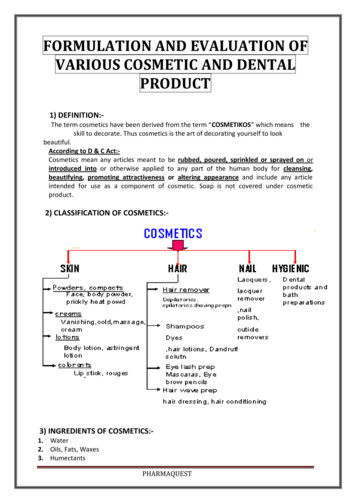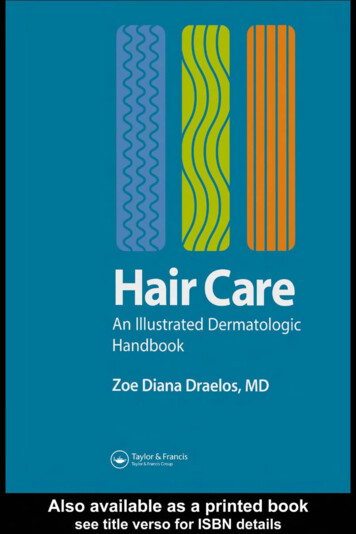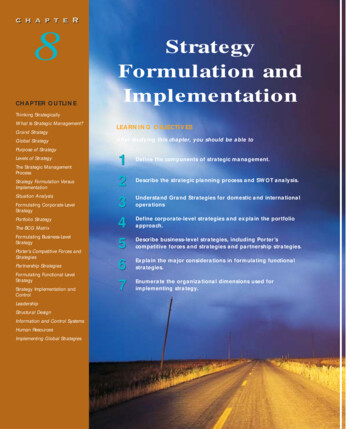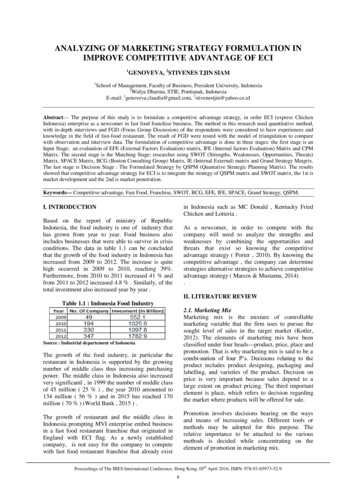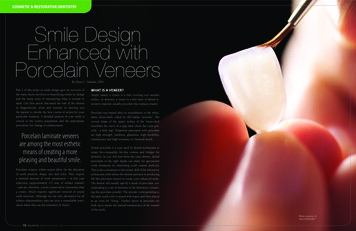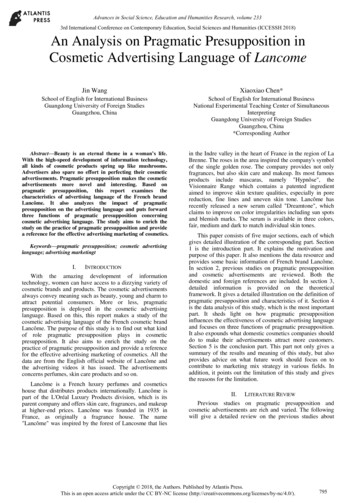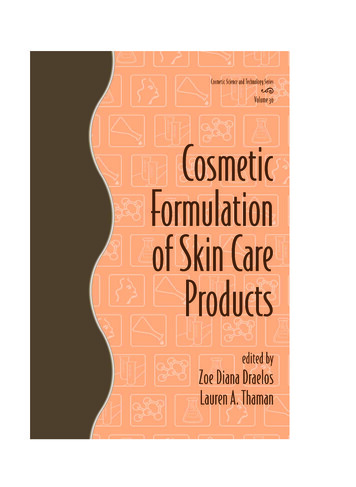
Transcription
DK9685 half-series-title4/25/064:34 PMPage ACosmetic Formulationof Skin Care Products
DK9685 half-series-title4/25/064:34 PMPage BCOSMETIC SCIENCE AND TECHNOLOGYSeries EditorERIC JUNGERMANNJungermann Associates, Inc.Phoenix, c and Drug Preservation: Principles and Practice,edited by Jon J. KabaraThe Cosmetic Industry: Scientific and RegulatoryFoundations, edited by Norman F. EstrinCosmetic Product Testing: A Modern PsychophysicalApproach, Howard R. MoskowitzCosmetic Analysis: Selective Methods and Techniques,edited by P. BoréCosmetic Safety: A Primer for Cosmetic Scientists,edited by James H. WhittamOral Hygiene Products and Practice, Morton PaderAntiperspirants and Deodorants, edited by Karl Ladenand Carl B. FelgerClinical Safety and Efficacy Testing of Cosmetics,edited by William C. WaggonerMethods for Cutaneous Investigation, edited byRobert L. Rietschel and Thomas S. SpencerSunscreens: Development, Evaluation, and RegulatoryAspects, edited by Nicholas J. Loweand Nadim A. ShaathGlycerine: A Key Cosmetic Ingredient, edited byEric Jungermann and Norman O. V. SonntagHandbook of Cosmetic Microbiology, Donald S. OrthRheological Properties of Cosmetics and Toiletries,edited by Dennis LabaConsumer Testing and Evaluation of Personal CareProducts, Howard R. MoskowitzSunscreens: Development, Evaluation, and RegulatoryAspects. Second Edition, Revised and Expanded,edited by Nicholas J. Lowe, Nadim A. Shaath,and Madhu A. Pathak
DK9685 half-series-title4/25/064:34 PMPage C16. Preservative-Free and Self-Preserving Cosmeticsand Drugs: Principles and Practice, edited byJon J. Kabara and Donald S. Orth17. Hair and Hair Care, edited by Dale H. Johnson18. Cosmetic Claims Substantiation, edited by Louise B. Aust19. Novel Cosmetic Delivery Systems, edited byShlomo Magdassi and Elka Touitou20. Antiperspirants and Deodorants: Second Edition,Revised and Expanded, edited by Karl Laden21. Conditioning Agents for Hair and Skin, edited byRandy Schueller and Perry Romanowski22. Principles of Polymer Science and Technology inCosmetics and Personal Care, edited byE. Desmond Goddard and James V. Gruber23. Cosmeceuticals: Drugs vs. Cosmetics, edited byPeter Elsner and Howard I. Maibach24. Cosmetic Lipids and the Skin Barrier, edited byThomas Förster25. Skin Moisturization, edited by James J. Leydenand Anthony V. Rawlings26. Multifunctional Cosmetics, edited by Randy Schuellerand Perry Romanowski27. Cosmeceuticals and Active Cosmetics: Drugs VersusCosmetics, Second Edition, edited by Peter Elsnerand Howard I. Maibach28. Sunscreens: Regulations and Commercial Development,Third Edition, edited by Nadim A. Shaath29. Biotechnology in Personal Care, edited by Raj Lad30. Cosmetic Formulation of Skin Care Products, edited byZoe Diana Draelos and Lauren A. Thaman
DK9685 half-series-title4/25/064:34 PMPage iCosmetic Formulationof Skin Care Productsedited byZoe Diana DraelosWake Forest University School of MedicineWinston-Salem, North Carolina, U.S.A.Lauren A. ThamanP&G BeautyCincinnati, Ohio, U.S.A.New York LondonTaylor & Francis is an imprint of theTaylor & Francis Group, an informa business
Taylor & Francis Group270 Madison AvenueNew York, NY 10016 2006 by Taylor and Francis Group, LLCTaylor & Francis is an Informa businessNo claim to original U.S. Government worksPrinted in the United States of America on acid-free paper10 9 8 7 6 5 4 3 2 1International Standard Book Number-10: 0-8493-3968-5 (Hardcover)International Standard Book Number-13: 978-0-8493-3968-4 (Hardcover)Library of Congress Card Number 2006040471This book contains information obtained from authentic and highly regarded sources. Reprinted material is quotedwith permission, and sources are indicated. A wide variety of references are listed. Reasonable efforts have been madeto publish reliable data and information, but the author and the publisher cannot assume responsibility for the validity of all materials or for the consequences of their use.No part of this book may be reprinted, reproduced, transmitted, or utilized in any form by any electronic, mechanical,or other means, now known or hereafter invented, including photocopying, microfilming, and recording, or in anyinformation storage or retrieval system, without written permission from the publishers.For permission to photocopy or use material electronically from this work, please access www.copyright.com (http://www.copyright.com/) or contact the Copyright Clearance Center, Inc. (CCC) 222 Rosewood Drive, Danvers, MA01923, 978-750-8400. CCC is a not-for-profit organization that provides licenses and registration for a variety ofusers. For organizations that have been granted a photocopy license by the CCC, a separate system of payment hasbeen arranged.Trademark Notice: Product or corporate names may be trademarks or registered trademarks, and are used only foridentification and explanation without intent to infringe.Library of Congress Cataloging-in-Publication DataCosmetic formulation of skin care products / edited by Zoe Diana Draelos, Lauren A. Thaman.p. cm. -- (Cosmetic science and technology ; v. 30)Includes bibliographical references and index.ISBN-13: 978-0-8493-3968-4 (acid-free paper)ISBN-10: 0-8493-3968-5 (acid-free paper)1. Cosmetic delivery systems. 2. Skin--Care and hygiene. 3. Cosmetics. I. Draelos, Zoe Diana. II.Thaman, Lauren. III. Cosmetic science and technology series ; v. 30.TP983.3.C67 2006668’.55--dc22Taylor & Francis Group is the Academic Division of Infomra plc.DK9685 Discl.indd 12006040471Visit the Taylor & Francis Web site athttp://www.taylorandfrancis.com5/2/06 11:24:26 AM
About the SeriesThe Cosmetic Science and Technology series was conceived to permit discussion of abroad range of current knowledge and theories of cosmetic science and technology. Theseries is composed of books written by either one or two authors or edited volumes with anumber of contributors. Authorities from industry, academia, and the governmentparticipate in writing these books.The aim of the series is to cover the many facets of cosmetic science and technology.Topics are drawn from a wide spectrum of disciplines ranging from chemistry, physics,biochemistry and dermatology to consumer evaluations, safety issues, efficacy, toxicityand regulatory questions. Organic, inorganic, physical, analytical and polymer chemistry,microbiology, emulsion and lipid technology all play important roles in cosmetic science.There is little commonality in the scientific methods, processes and formulationsrequired for the wide variety of toiletries and cosmetics in the market. Products range fromhair, skin, and oral care products to lipsticks, nail polishes, deodorants, body powders andaerosols, to cosmeceuticals which are quasi-pharmaceutical over-the-counter productssuch as antiperspirants, dandruff shampoos, wrinkle reducers, antimicrobial soaps, acnetreatments, or sun screen products.Emphasis in the Cosmetic Science and Technology series is placed on reporting thecurrent status of cosmetic science and technology, the ever-changing regulatory climate,and historical reviews. The series has now grown to 30 books dealing with the constantlychanging trends in the cosmetic industry, including globalization. Several of the bookshave been translated into Japanese and Chinese. Contributions range from highlysophisticated and scientific treaties to primers and presentations of practical applications.Authors are encouraged to present their own concepts as well as established theories.Contributors have been asked not to shy away from fields that are in a state of transition orsomewhat controversial, and not to hesitate to present detailed discussions of their ownwork. Altogether, we intend to develop in this series a collection of critical surveys andideas covering the diverse phases of the cosmetic industry.The thirtieth book in this series, Cosmetic Formulation of Skin Care Products editedby Zoe Diana Draelos, MD and Lauren Thaman, MS comprises 22 chapters authored orco-authored by over 30 experts in the field. The development of cosmetics and toiletriesrepresents a highly diversified field involving many subsections of science and “art.” Itcovers the discovery of novel raw materials, development and manufacture of uniqueformulations, ever more sophisticated testing methods particularly in the areas of safety,clinical and performance efficacy evaluations, and claim substantiation. But even in thesedays of high technology and ever increasing scientific sophistication, art and intuitioncontinue to play an important part in the development of formulations, their evaluation,iii
ivAbout the Seriesselection of raw materials, and, perhaps most importantly, the successful marketing of newproducts. Aesthetic considerations, such as fragrance, color, packaging and productpositioning often can be as important to the success of a new cosmetic product asdelivering the promised (implied) performance or the use of a new magic ingredient.The application of more sophisticated methodologies to the evaluation of cosmeticsthat began in the 1980s has continued and has greatly impacted such areas as claimsubstantiation, safety and efficacy testing, product evaluations and testing, development ofnew raw materials, such as biotechnology products, for example products produced bymicroorganisms where genes are modified by recombinant DNA technologies. Butregardless how great the science and the medical proofs behind a new product, bad or justindifferent aesthetics can hurt the performance in the marketplace.New cosmetic formulations usually are the result of systematic developmentprograms sponsored by corporations and carried out either in their own laboratories or bysponsored programs in cooperation with consulting laboratories. Their developmentinvolves individuals with diverse backgrounds, experience, and objectives. Thoughmulti-tasking has become a favorite buzzword, there are obvious limitations. Topmanagement and marketing and advertising executives identify areas of new productdevelopment that were either developed internally or brought to their attention byvarious outsides sources. This sometimes leads to a push for extravagant claims thatmight require the repeal of one or more laws of nature. The product developmentchemists (formulators) in the laboratory are then charged with meeting the performanceobjectives and product parameters set by management. In addition, they have to beconcerned with a host of considerations, ranging from safety issues, global regulations,raw material cost and availability, awareness of the competitive climate, patent status,adequate preservation, stability and compatibility issues, product scale-up and productionproblems, to cosmetic elegance considerations, such as fragrance selection, color, andpackaging. Finally, there is the medical fraternity, often dermatologists, devising andsupervising efficacy and safety tests concerned with the performance of the products.This can be a key activity particularly with cosmeceuticals and other products makingclinical claims that need substantiation and scientific credibility.When looking at the total process of developing and commercializing a newcosmetic product, there are a number of stakeholders: top management, marketing andsales, R&D and operations, academic support groups, and consultants. These groups mayhave quite different philosophical approaches and goals. While all share a common goal ofcoming up with a commercially successful product, there are often real differences in howthe various groups view or perceive the project. Some are clearly business-driven; othersare science-driven.This book tries to bridge some of these differences. Business-driven activitiesinclude top management’s desire to have the product in the market place with goodcustomer acceptance, a strong business plan and strategy, and good profit margins;involvement in the details on how this is achieved is secondary. To quote a speaker(Harvey Gedeon, Estee Lauder Companies) at the 2005 Annual meeting of Society ofCosmetic Chemists, “Management expects us to create low-cost breakthrough productsthat are the best-in-category.” Marketing and sales are concerned with developing themarketing strategies and coordinating and directing the management of the new productor brand. Science-driven activities predominate in the laboratory. The formulators andthe clinical workers attacking the various technical problems will be intrigued by theuse of new chemicals, clever processing techniques, patentability and new testingtechniques, often involving expensive new and intriguing new technical tools to solvethe technical challenges presented by the project. Sometimes too many technical
About the Seriesvtangents can delay the timely resolution of new product development projects. Buildinga good communication bridge between the business and different science-driven groupsis the key to the success of a new cosmetic product.I want to thank all the contributors and the editors, Zoe Diana Draelos, MD andLauren Thaman, MS for participating in the Cosmetic Science and Technology series andthe Informa Healthcare organization, particularly Sandra Beberman, with whom I haveworked since the inception of this series twenty-five years ago, for their support and help.Eric Jungermann, PhD
I dedicate this book to my two sons, Mark and Matthew,who constantly challenge me to see the world in new fresh ways!Zoe Diana DraelosI dedicate this book to my many P&G colleagueswho consistently demand and force me to think what’s next.Lauren Thaman
PrefaceCosmetic formulation is becoming increasingly complex given the challenges offormulating for a technologically sophisticated consumer. This text is designed to meetthe needs of the cosmetic chemist, scientist, dermatologist and formulator who mustunderstand a wide range of issues to create successful, novel skin care products for adiverse population. To accomplish this end, the text is divided into the key knowledgeareas of cutaneous formulation issues, formulation development, raw materials and activeingredients, and product testing, efficacy, and clinical assessment. The section oncutaneous formulation deals with the unique aspects of formulating for specific body areas,such as the face, eyelids, lips, hands, underarms, etc., while discussing the needs of specialpopulations, such as individuals with sensitive skin, rosacea, atopic dermatitis, etc. Issuesspecific to both genders and all skin color types are presented. This initial section presentsthe framework necessary to design products that successfully perform in body areas withunique anatomic considerations while considering gender and ethnic differences.The text continues by delving into formulation development by product category:cleansers, moisturizers, toners, antiperspirants, and sunscreens. This allows the reader totake the information learned in section one regarding unique anatomic needs and createskin care products by employing state-of-the-art formulation chemistry. However, the skincare industry has moved beyond basic skin maintenance product categories into activesdesigned to deliver skin-enhancing benefits. These areas of skin treatment include therealms of acne, photoaging, dyspigmentation, and inflammation. Actives that are importantin these areas include salicylic acid, benzoyl peroxide, hydroxy acids, retinoids, vitamins,hydroquinone, antioxidants, botanicals, etc. Understanding the mechanism of action andformulation issues regarding these actives allows the creation of skin care products thatdeliver benefits into the treatment realm beyond maintenance.In summary, the text presents diverse knowledge sets from dermatology, cosmeticchemistry, and product formulation. It synthesizes the information into one cohesive unitfor practical application by the dermatologist, cosmetic chemist, formulator, or testingfacility. Only by understanding all aspects of cosmetic formulation can technology expandthe skin care marketplace.Zoe Diana DraelosLauren A. Thamanix
ContentsAbout the SeriesEric Jungermann : : : : iiiPreface : : : : ixContributors : : : : xix1. Cosmetic Formulation of Skin Care Products . . . . . . . . . . . . . . . . . . 1Zoe Diana DraelosIntroduction: How to Utilize This Text : : : : 1PART I: CUTANEOUS FORMULATION ISSUES2. Cutaneous Formulation Issues . . . . . . . . . . . . . . . . . . . . . . . . . . . . . 3Zoe Diana DraelosSite-Specific Cutaneous Needs : : : : 3Suggested Readings : : : : 263. Formulation for Special Populations . . . . . . . . . . . . . . . . . . . . . . . . 27Zoe Diana DraelosGender : : : : 27Age Issues : : : : 28Skin Color : : : : 29Hair Shaft Architecture : : : : 30Sensitive Skin : : : : 31Contact Dermatitis Issues : : : : 32Acne Issues : : : : 34Summary : : : : 34References : : : : 34PART II: FORMULATION DEVELOPMENT AND APPLICATION4. Personal Cleansing Products: Properties and Use . . . . . . . . . . . . . . 35Keith ErtelIntroduction : : : : 35xi
xiiContentsSkin Cleansing : : : : 35Personal Cleanser Effects on Skin : : : : 40Some Practical Considerations When Choosing a PersonalCleanser : : : : 54References : : : : 595. Toners and Astringents . . . . . . . . . . . . . . . . . . . . . . . . . . . . . . . . . . 67Melanie SmithIntroduction : : : : 67Product Nomenclature : : : : 67Function and Order of Application Within aSkin Care Regimen : : : : 68Formulation Considerations : : : : 68Product Claims : : : : 73Claims Testing Methods : : : : 74Uses in Dermatology : : : : 74Adverse Reactions : : : : 75Summary : : : : 75References : : : : 766. The Dry Skin Cycle . . . . . . . . . . . . . . . . . . . . . . . . . . . . . . . . . . . . . 79Paul J. Matts and Anthony V. RawlingsIntroduction : : : : 79Stratum Corneum and Epidermal Structure : : : : 80Stratum Corneum Lipid Chemistry and Biophysics : : : : 81Stratum Corneum Corneodesmosomesand Corneodesmolysis : : : : 84Corneocyte Envelope Maturation and the Role ofTransglutaminases : : : : 87Stratum Corneum Natural Moisturizing Factors (NMF) : : : : 89The Effect of Humidity on Epidermal Differentiation andStratum Corneum Quality : : : : 92The Pathophysiology of Winter- and Soap-Induced Dry Skin : : : : 93The “Dry Skin Cycle” Model: A New Way to DescribeInduction and Propagation of the Xerosis : : : : 96Management of Dry Skin : : : : 99Summary and Conclusions : : : : 106References : : : : 1077. Factors Influencing Optimal Skin Care and Product Selection . . . 115James Q. Del RossoBasic Skin Care Processes : : : : 115The Epidermal Barrier and Water Content : : : : 116Epidermal Barrier Integrity, Function, and Repair : : : : 117Impact of Exogenous Moisturization on Barrier Repair : : : : 117Clinical Implications of Exogenous Moisturization : : : : 117
ContentsxiiiComponents of Moisturizer Formulations : : : : 118Balancing Effects and Cosmetic Elegance ofProduct Components : : : : 118Formulation Characteristics : : : : 119Special Additives and Ingredients : : : : 119The Significance of Gentle Skin Cleansing : : : : 120Basic Cleanser Formulations : : : : 120Conclusion : : : : 120References : : : : 1218. Antiperspirants . . . . . . . . . . . . . . . . . . . . . . . . . . . . . . . . . . . . . . . 123John E. Wild, A. C. Lanzalaco, and D. F. SwaileIntroduction : : : : 123Antiperspirants : : : : 124Antiperspirant Efficacy : : : : 126Formulation : : : : 128Formulating for the Consumer : : : : 131Introducing New Antiperspirant Active Formulations : : : : 131Medical Approaches to Hyperhidrosis : : : : 131References : : : : 134PART III: ACTIVE INGREDIENTS FOR SKIN TREATMENT9. Sunscreens . . . . . . . . . . . . . . . . . . . . . . . . . . . . . . . . . . . . . . . . . . 135J. F. Nash and Paul R. TannerIntroduction : : : : 135Sunscreens : : : : 136Self-Tanning Products : : : : 141Formulation Challenges : : : : 143Regulatory Issues : : : : 144Safe Sun Strategy : : : : 145Conclusions : : : : 148References : : : : 14910. Photoprotection and the Prevention of Photocarcinogenesis . . . . . 153Nathalie Nguyen and Darrell S. RigelOverview : : : : 153Relationship of UV Exposure to Skin Cancer Development : : : : 154Spectral Differences Related to UV Photocarcinogenesis : : : : 155Photocarcinogenesis-Decreasing PhotoprotectionModalities : : : : 155Sunscreens : : : : 156Types of Sunscreens and Mechanisms of Action : : : : 156Chemical Sunscreens : : : : 157Physical Sunscreens : : : : 159Photocarcinogenesis Reduction by Wearing Clothing : : : : 159
xivContentsBehavior Modification : : : : 160Effectiveness of Photoprotection : : : : 160Photoprotection and Vitamin D : : : : 160Patient Recommendations and Future Directions : : : : 161References : : : : 16211. Anti-aging Skin Care Formulations . . . . . . . . . . . . . . . . . . . . . . . 167Donald L. BissettIntroduction : : : : 167Vitamin A : : : : 167Vitamin B3 : : : : 170Vitamin C : : : : 174Peptides : : : : 176Dimethylaminoethanol (DMAE) : : : : 178Kinetin (N6-Furfuryladenine) : : : : 179Triterpenoids : : : : 180Ubiquinone (Co-Enzyme Q10) : : : : 181Other Technologies : : : : 181Discussion : : : : 181References : : : : 18312. The Role of Cosmeceuticals in Dermatology . . . . . . . . . . . . . . . . . 187David H. McDaniel, Joseph DiNardo, and Joseph LewisWhat Are “Cosmeceuticals”—Cosmetics vs. RX Drugs : : : : 187Domestic and International Regulatory GuidelinesImpacting Cosmetics : : : : 191Categories of Currently Popular Cosmeceuticalsin Dermatology : : : : 192How to Select the “Best” Formulation of a Cosmeceutical : : : : 199The Future of Cosmeceuticals : : : : 200References : : : : 20213. Skin Lightening Agents . . . . . . . . . . . . . . . . . . . . . . . . . . . . . . . . . 205Wen-Yuan Zhu and Ru-Zhi ZhangTyrosinase Inhibition : : : : 205Product Reduction and Reactive Oxygen Species : : : : 209Inhibition of Melanosome Transfer : : : : 211Skin Turnover Acceleration : : : : 212Traditional Chinese Medicine : : : : 213References : : : : 21514. Medical and Surgical Approaches to Skin LighteningMarta I. Rendon and Jorge I. GaviriaIntroduction : : : : 219Topical Depigmenting Agents : : : : 221Phenolic Depigmenting Agents : : : : 221Non-Phenolic Agents : : : : 224. . . . . . . . . 219
ContentsxvTopical Cosmeceuticals : : : : 225Botanicals : : : : 226Physical Therapies : : : : 226Chemical Peels : : : : 227Microdermabrasion : : : : 228Dermabrasion : : : : 228Lasers : : : : 228Our Therapeutic Approach : : : : 230Conclusions : : : : 231References : : : : 23215. Topical Exfoliation—Clinical Effects and FormulatingConsiderations . . . . . . . . . . . . . . . . . . . . . . . . . . . . . . . . . . . . . . . 237M. Elizabeth Briden and Barbara A. GreenExfoliation : : : : 237Physical Exfoliants: Scratching the Surface : : : : 238Chemical Exfoliation : : : : 239Conclusion : : : : 247References : : : : 24716. Over-the-Counter Acne Medications . . . . . . . . . . . . . . . . . . . . . . . 251Theresa Chen and Yohini AppaIntroduction : : : : 251Clinical Considerations : : : : 252Highlights of Over-the-Counter Acne Monograph : : : : 253Formulation of Over-the-Counter Acne Products : : : : 253Trends in Over-the-Counter Acne Formulations : : : : 254Advances in Over-the-Counter Acne Formulations : : : : 255Summary : : : : 267References : : : : 26817. Acne Treatment Methodologies . . . . . . . . . . . . . . . . . . . . . . . . . . . 273Emmy M. Fernandez, Andrea L. Zaenglein, and Diane M. ThiboutotIntroduction : : : : 273Morphology : : : : 276Topical Retinoid : : : : 276Cleansers : : : : 279Hydroxy Acids : : : : 279Benzoyl Peroxide : : : : 281Other Topical Treatments : : : : 281Oral Antibiotics : : : : 281Hormonal Therapy : : : : 286Isotretinoin : : : : 287Manual Treatments : : : : 290Phototherapy : : : : 291References : : : : 292
xviContents18. Topical Botanicals . . . . . . . . . . . . . . . . . . . . . . . . . . . . . . . . . . . . . 297Tracy Cornuelle and Jan LephartIntroduction : : : : 297Selecting Plant Species : : : : 298Sourcing Plant Material : : : : 298Accurate Identification of Plant Species : : : : 299Harvesting Plant Material : : : : 299Cosmetic Extracts : : : : 300Standardization of Extracts : : : : 302Quality Issues : : : : 303Safety and Toxicology : : : : 304Conclusions : : : : 305References : : : : 30519. Herbs in Cosmeceuticals: Are They Safe and Effective? . . . . . . . . 309Carl ThornfeldtBackground : : : : 309Processing Botanicals : : : : 310Regulatory Climate : : : : 311Adverse Reactions : : : : 311Specific Herbs : : : : 328Summary : : : : 347References : : : : 34720. Topical Anti-inflammatories . . . . . . . . . . . . . . . . . . . . . . . . . . . . . 351Bryan B. Fuller and Dustin R. SmithIntroduction : : : : 351Biology of Skin Inflammation : : : : 351Prescription and Over-the-Counter Treatments for Inflammation andMechanism of Action : : : : 353Anti-inflammatory Cosmeceutical “Actives” : : : : 361Biological Screening Assays to Identify NovelAnti-inflammatory Compounds : : : : 363Development of Effective Topical Formulations : : : : 368Conclusions : : : : 373References : : : : 37321. Topical Nutritional Antioxidants . . . . . . . . . . . . . . . . . . . . . . . . . . 377Karen E. BurkeIntroduction : : : : 377Vitamin C : : : : 377Vitamin E : : : : 379Selenium : : : : 384New Combinations of Antioxidants : : : : 386Soy Extract: Genistein : : : : 387Alpha-Lipoic Acid : : : : 390
ContentsxviiUbiquinone : : : : 394Summary : : : : 395References : : : : 39622. What Is Next in Skin Care Cosmetic Products? . . . . . . . . . . . . . . 403Lauren A. ThamanCosmeceuticals : : : : 403Nutraceuticals : : : : 405Medical Mimics : : : : 405Customized Products : : : : 406Skin Tone Alteration : : : : 406Delivery Systems : : : : 407New Users : : : : 407The Skin Care Market : : : : 407References : : : : 408Index : : : : 409
ContributorsNeutrogena Skincare Institute, Los Angeles, California, U.S.A.Yohini AppaP&G Beauty, Miami Valley Innovation Center, Cincinnati, Ohio,Donald L. BissettU.S.A.M. Elizabeth BridenMinnesota, U.S.A.Advanced Dermatology and Cosmetic Institute, Edina,Karen E. BurkeDepartment of Dermatology, Mount Sinai Medical Centerand Department of Medicine, Cabrini Medical Center, New York, New York, U.S.A.Neutrogena Skincare Institute, Los Angeles, California, U.S.A.Theresa ChenTracy CornuelleU.S.A.Research and Development, Nu Skin Enterprises, Provo, Utah,James Q. Del RossoDepartment of Dermatology, University of Nevada School ofMedicine, Las Vegas, Nevada, U.S.A.Joseph DiNardoPharma Cosmetix Research, LLC, Richmond, Virginia, U.S.A.Zoe Diana DraelosDepartment of Dermatology, Wake Forest University School ofMedicine, Winston-Salem, and Dermatology Consulting Services, High Point, NorthCarolina, U.S.A.Keith ErtelP&G Beauty, Sharon Woods Technical Center, Cincinnati, Ohio, U.S.A.Emmy M. FernandezDepartment of Dermatology, Pennsylvania State UniversityMilton S. Hershey Medical Center, Hershey, Pennsylvania, U.S.A.Bryan B. FullerDepartment of Biochemistry and Molecular Biology, University ofOklahoma Health Sciences Center, Oklahoma City, Oklahoma, U.S.A.Jorge I. GaviriaMedical Hair Research Group, Inc. and Clinical Research, Skin CareResearch, Inc., Boca Raton, Florida, U.S.A.Barbara A. GreenA. C. LanzalacoOhio, U.S.A.NeoStrata Company, Inc., Princeton, New Jersey, U.S.A.P&G Beauty, Sharon Woods Technical Center, Cincinnati,xix
xxContributorsResearch and Development, Nu Skin Enterprises, Provo, Utah, U.S.A.Jan LephartJoseph LewisPharma Cosmetix Research, LLC, Richmond, Virginia, U.S.A.Paul J. MattsP&G Beauty, Rusham Park Technical Center, Egham, Surrey, U.K.The Institute of Anti-Aging Research, Virginia Beach, Virginia,David H. McDanielU.S.A.J. F. NashP&G Beauty, Sharon Woods Technical Center, Cincinnati, Ohio, U.S.A.Nathalie NguyenDepartment of Dermatology, New York University School ofMedicine, New York, New York, U.S.A.Anthony V. RawlingsAVR Consulting Ltd., Northwich, Cheshire, U.K.Marta I. RendonDermatology and Aesthetic Center and University of Miami,Miami, and Florida Atlantic University, Boca Raton, Florida, U.S.A.Darrell S. RigelDepartment of Dermatology, New York University School ofMedicine, New York, New York, U.S.A.Dustin R. SmithDepartment of Biochemistry and Molecular Biology,University of Oklahoma Health Sciences Center, Oklahoma City, Oklahoma, U.S.A.Melanie SmithD. F. SwaileMary Kay Inc., Dallas, Texas, U.S.A.P&G Beauty, Sharon Woods Technical Center, Cincinnati, Ohio, U.S.A.P&G Beauty, Sharon Woods Technical Center, Cincinnati, Ohio,Paul R. TannerU.S.A.Lauren A. ThamanU.S.A.P&G Beauty, Sharon Woods Technical Center, Cincinnati, Ohio,Diane M. ThiboutotDepartment of Dermatology, Pennsylvania State UniversityMilton S. Hershey Medical Center, Hershey, Pennsylvania, U.S.A.Carl ThornfeldtEpisciences, Inc., Boise, and CT Derm, Fruitland, Idaho, and OregonHealth Sciences University, Portland, Oregon, U.S.A.John E. WildHill Top Research, Miamiville, Ohio, U.S.A.Andrea L. ZaengleinDepartment of Dermatology, Pennsylvania State UniversityMilton S. Hershey Medical Center, Hershey, Pennsylvania, U.S.A.Ru-Zhi ZhangDepartment of Dermatology, The Affiliated Hospital, BangBuMedical College, BangBu, P.R. ChinaWen-Yuan ZhuDepartment of Dermatology, The First Affiliated Hospital, NanjingMedical University, Nanjing, P.R. China
1Cosmetic Formulation of SkinCare ProductsZoe Diana DraelosDepartment of Dermatology, Wake Forest University School of Medicine,Winston-Salem, and Dermatology Consulting Services, High Point,North Carolina, U.S.A.INTRODUCTION: HOW TO UTILIZE THIS TEXTThe formulation of skin care products requires a cross-disciplinary knowledge base, whichcan be difficult to obtain. How can any individual obtain the knowledge of a dermatologist,the expertise of a PhD biochemist, the experience of a cosmetic chemist, and the insight ofa research and development scientist? There is not enough time in one lifetime to masterall of these disciplines. It ta
The thirtieth book in this series, Cosmetic Formulation of Skin Care Products edited by Zoe Diana Draelos, MD and Lauren Thaman, MS comprises 22 chapters authored or co-authored by over 30 experts in the field. The development of cosmetics and toiletries represents a highly diversifie
